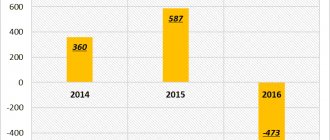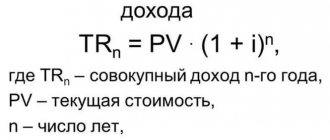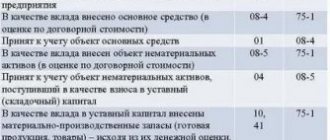Hello, Vasily Zhdanov, in this article we will look at an example of calculating the total capital of an enterprise. As practice shows, concepts such as “your own or your own capital”, “your own or your own funds”, as well as “net assets” are used as synonyms. In fact, they are truly interchangeable since their definitions are largely consistent. The words “own” and “your” are essentially identical. And economists quite rightly use the term “capital” when describing assets. Although its exact definition is capital - a combination of debt and equity capital.
An example of borrowed capital can be virtually any short-term and long-term obligations of an organization to individuals and other legal entities. Most often, credits and loans act in this capacity. Meanwhile, the enterprise’s capital (its own, its own) is considered from different positions.
Take our proprietary course on choosing stocks on the stock market → training course
In general, it is customary to say that your capital is part of the book. balance sheet, which reflects the residual claim of the founders to the legal entity they formed. During each reporting period it may change: decrease or increase. Its value depends on two main factors:
- Additional investments (for example, receiving valuables for free).
- The results of your own activities (for example, the net profit for a specific reporting period).
In fact, the following rule applies. The value of net assets changes (decreases or increases) over a specific period, and accordingly, the enterprise’s capital also changes. One change follows from another.
Brief description and composition of the enterprise’s capital
The capital of an organization can be monetary (i.e., in monetary terms, in money) or real, implying its expression in the means of production. This approach is considered the most optimal in terms of capital.
As is customary, money capital (MC), in other words, money is used by an organization for the purpose of purchasing means of production. At the same time, the funds that go to support households. activities can be either own or borrowed. Characterizing equity capital from this side, it should be noted that:
- it means the monetary value of property owned by the enterprise;
- it is taken into account as the difference between the book value of this property and the liabilities that the enterprise has at that moment;
Important! The value of the property includes, among other things, amounts unclaimed from debtors.
- its composition takes into account different sources, such as: profits from the results of its activities, authorized capital, share capital, as well as contributions and donations.
Thus, the composition of its capital includes the amounts of: authorized, reserve, additional capital (MC, RK and, accordingly, DC), as well as retained earnings (RE) and targeted financing.
Own capital (hereinafter also abbreviated as SK) gives the right to participate in the management of the organization. The sources of its formation can be external and internal, and the key area of its financing is long-term assets. Meanwhile, specific terms with terms of payment and return have not been determined.
What is own working capital
Working capital
A company is considered financially sound when it has a balanced capital structure, is attractive to investors and can repay its debts on time.
Own working capital (WCC) is an indicator that is used when analyzing the balance sheet. This value reflects exactly what proportion of the company’s own funds is used in turnover, that is, goes to cover its current assets.
Attention! According to the standard rule, the following ratio must be maintained between the sections of the balance sheet: non-current assets (abbreviated as VNA) are formed from own funds, as well as long-term liabilities; working capital (OA) - through short-term loans and internal sources of financing.
The main components of its capital (MC, RK, DC and NP) in accounting. balance sheet
Own capital, or more precisely, all its components (MC, RK, DC and NP), are fully represented in the accounting. balance sheet No. 1. The current balance sheet form, corresponding to OKUD 0710001, was introduced by Order of the Ministry of Finance of the Russian Federation No. 66n dated 07/02/2010. The latest changes to the wording of this order are dated April 19, 2019. The named components of the insurance company correspond to balance sheet lines 1310-1370. The insurance amount itself is written down on page 1300.
| Line by line distribution by book. balance | ||||
| UK | Revaluation of VA | DK | RK | NP |
| 1310 | 1340 | 1350 | 1360 | 1370 |
It should be noted that this balance sheet interpretation of the SC concept is traditional and most widespread. Moreover, this approach is used not only in domestic practice, but also abroad. In this regard, it is advisable to separately consider each component (MC, RK, DC and NP) of equity capital.
Authorized capital (AC) according to accounting. the balance sheet consists, literally, of “shared capital, authorized capital and contributions of partners.” In other words, this is the totality of all funds brought by the founders of an enterprise or organization into the property directly upon its formation. The sizes of these deposits, shares (other) are determined, as established, by the constituent documentation. Its corresponding value is subject to recording during state registration.
Reserve capital (RC) is a certain part of your capital. It is usually allocated from profit for the purpose of covering potential, expected losses. The size of the Republic of Kazakhstan and its features, the formation procedure are established by the legislation of the Russian Federation and the organization’s charter itself.
Additional capital (AC) is the price of property that was brought in by the founders of the organization after state registration of the size of the capital. These are already excess amounts generated from other cash receipts in the insurance company. Such an amount, for example, may arise as a result of a property revaluation, which revealed changes in the price of property.
Another important component of an enterprise’s capital is its retained earnings (RE). It is considered an absolute indicator of the effective performance of enterprises, reflecting retained earnings received for a specific period of operation. This part of the VP is after taxes are deducted and funds are transferred to other purposes.
The insurance company also includes investment and accumulated capital. The first includes the investments of the founders themselves, and the second, accumulated, includes that part of the capital that is formed and brought in above the first. The composition of SC can be shown schematically in the following way.
It is important to know and distinguish the terms listed above and their definitions, since they are involved in the formation and calculation of the insurance system.
Results
The amount of fixed capital at residual value consists of the indicators of the lines of the 1st section of the balance sheet “Non-current assets”, namely: 1110, 1120, 1130, 1140, 1150, 1160, 1170, 1190. The result obtained differs from the data in the final line 1100 by the amount deferred tax assets, since this asset is not included in fixed assets.
BALANCE
(balance sheet) - an accounting report on the assets and liabilities of the company on the last day of the operating period. The balance sheet lists all the assets owned by the company, and against them are indicated the company's offsetting liabilities or the claims of those people who provided it with the funds to acquire these assets. Assets are divided into fixed assets (fixed assets) and current assets, while liabilities consist of share capital, long-term borrowings and current liabilities (current liabilities).
ASSETS
(asset) - an object of property owned by an individual or company and having a monetary value. There are three main types of assets:
(a) physical assets - factory buildings and equipment, land, durable consumer goods (cars, washing machines, etc.);
(b) financial assets - cash, bank deposits, shares;
(c) intangible assets - trademarks, etc.
GOODWILL
(goodwill) - the difference at a certain point in time between the market valuation of the company and the amount of its net assets recorded in the balance sheet. If another firm wants to acquire the firm, goodwill represents the premium that the buyer will have to pay to purchase the firm over and above the value of its assets. This is due to the firm's trade contracts, reputation, brands, management experience and know-how. If a firm is doing poorly, its market valuation by a potential buyer may be lower than the value of its assets on its balance sheet, in which case goodwill is negative.
MONEY
(tangible assets) - any assets in kind (plant, machines, equipment, vehicles and supplies) that have some monetary value.
INTANGIBLE ASSETS
(intangible assets) - property that does not have a physical form, such as goodwill, patents and trademarks, that has a monetary value.
PASSIVE
(liabilities) - one of the two sides of the balance sheet, characterizing the sources of capital formation of the company - its own funds and liabilities. Wed. ASSETS.
MAIN CAPITAL
(fixed assets) - assets (such as buildings and equipment) that a company acquires for the purpose of long-term use, rather than further resale. Fixed capital is used by an enterprise for a long time, and each year, as a rule, part of its original cost is written off (see depreciation, profit) to reflect the decrease in the value of the asset. On the balance sheet, fixed assets are usually stated at the purchase price minus depreciation to date. Some types of fixed assets, such as real estate, tend to appreciate in value (see asset appreciation) and must be revalued periodically to keep their book value in line with market value.
NET ACCOUNTING VALUE
( net book value ) - the accounting value of fixed capital on the company's balance sheet, which represents its original cost minus depreciation accrued to date.
CURRENT ASSETS
(current ass e ts) - assets such as inventories, money lent to debtors, and cash that the company holds for short-term financing of turnover: the purchase of raw materials and supplies, their processing, the sale of finished products and payment by customers.
CURRENT LIABILITIES
(current liabilities) - all obligations to pay cash by a certain date in the near future, including the company's debt to commercial creditors, as well as bank loans and overdrafts.
INCREASING ASSET PRICES
(appreciation) - long-term assets, such as industrial buildings, offices and residential buildings, as a rule, increase in price due to inflation and increased cost of land; the value of short-term assets such as stocks may also increase. When assets appreciate in value, their replacement cost exceeds their historical (original) cost, and therefore periodic revaluation of such assets may be necessary to ensure that their book value matches the market value.
INCREASE IN THE PRICE OF CAPITAL
(capital appreciation) - see asset price appreciation.
WORKING CAPITAL
(working capital) - short-term current assets of the company that quickly turn over during the production process. Working capital includes inventories of materials, work in progress and finished goods, accounts receivable (see debtor), cash less short-term current liabilities. An increase in the volume of a firm's activities usually results in an increase in inventories and accounts receivable and thus an increase in working capital requirements. Reducing the time between paying for materials, turning them into final products, selling these products and receiving money from consumers will lead to a decrease in the required working capital.
Calculation of the SC value using the updated accounting form. balance
There are several ways to determine the amount of SC. The simplest and most understandable is the accounting calculation. balance. It is based on the summation of the values of those indicators that actually form the sum of the capital insurance (they were discussed above) minus line 1320 (shares purchased from shareholders).
We are talking about four values: UK, RK, DC and NP, which correspond to balance sheet lines 1310, 1340, 1350, 1360, 1370. The balance sheet calculation formula in this case will be as follows:
To get the amount of the capital account for the year, you should add the value of the capital account at the beginning and at the end of the required period (year). Calculation is made according to the formula:
Abbreviations in formula 2: SK - own capital for the whole year, SK n.g. – your capital at the beginning of the corresponding year, SK k.g. – your capital at the end of the same year.
In addition to the above calculation options, there is also another method used taking into account the instructions of the Ministry of Finance of the Russian Federation, presented in Order No. 84n dated 08/28/2014 (as amended on 02/21/2018). This regulatory document establishes the procedure for determining the value of net assets, which must be followed by LLCs, JSCs, state unitary enterprises, municipal unitary enterprises, industrial and housing savings cooperatives, as well as households. partnerships.
From the procedure established by the Ministry of Finance, the provisions that determine the composition of assets and liabilities taken into account in the calculation are applied in practice. So, according to the current procedure, when calculating the value of the SC, take into account:
- all assets (except for those that reflect the debts of the founders or shareholders for authorized contributions);
- all liabilities (except for income of subsequent periods, especially related to government assistance and gratuitous receipt of property).
Guided by these standards, when calculating, they take data from lines 1600 (assets), 1400 (long-term liabilities) and 1500 (current liabilities). The value is calculated using the formula:
Abbreviations in formula 3: DU - the amount of debt of the founders of the household. society, DBP - the amount of income of subsequent, future periods.
When calculating the insurance company, you should also take into account the basic formula, which is quite simple and looks like this:
The balance sheet currency is the total amount for all component accounts. balance. Moreover, the total amount of assets = the total amount of liabilities.
To help investors: how to analyze bank statements
The significance of assessing bank statements is due to the global role of the banking system in the state’s economy. The bank, as a financial intermediary between persons with temporarily free capital and those who need to finance their activities, performs the function of the country's circulatory system.
The objectivity of investment decisions made depends on the completeness of the data provided by banks and their reliability. Taking into account the dynamics of financial and operational indicators allows for a rational choice of bank shares as an investment object.
When analyzing bank statements, one should take into account the characteristics of credit financial institutions (banks) in relation to non-financial – production and service enterprises.
Firstly , this is a high proportion of borrowed capital in the structure of the balance sheet (statement of financial position) with a low share of equity capital. For example, for Sberbank of Russia, the share of own funds in the balance sheet currency at the end of the second quarter. 2021 was about 13%.
This fact is natural for the banking industry, since the main activity of a financial intermediary is to attract borrowed funds with their subsequent provision to persons interested in capital on the basis of urgency, payment and repayment.
The bank’s own capital plays the role of a “safety cushion” in case of unforeseen expenses associated with unfavorable business conditions and a possible outflow of depositors’ funds.
The bank's capital (own funds) is considered as the maximum amount of guarantees for its obligations.
For non-financial organizations, such a low share of equity capital relative to the amount of borrowed funds would mean a deterioration in the financial situation and a decrease in financial stability, which could lead to bankruptcy of the organization. An exception may be industries characterized by high capital turnover, for example, retail trade enterprises.
Secondly , a significant difference between banks and manufacturing enterprises is the process of regulating their activities.
In this case, the Central Bank of the Russian Federation, acting as a regulator of the banking system, establishes mandatory performance standards, compliance with which is designed to reduce the risks of the functioning of a credit institution and protect depositors and counterparties from possible losses of their funds.
23 mandatory standards of the Central Bank have been established, characterizing capital adequacy, asset liquidity, maximum amounts of active operations and the amount of various types of risk. The main ones are capital adequacy and liquidity standards.
Thirdly , a distinctive feature of banking activities is the accounting process.
Continuous, daily banking accounting of turnovers and account balances is due to the need to monitor the rational use of financial resources and assess the risks of banking operations.
In Figure 1 we present a list of indicators and multipliers used for rapid assessment of the activities of a credit institution and its value.
To make an informed investment decision, we will consider a set of performance indicators of a credit institution, grouping them into 3 blocks.
It should be noted that the absolute values of indicators are interesting for comparing the scale of an organization’s activities and determining its place in a competitive environment.
To assess the effectiveness of a bank’s activities, it is first necessary to take into account the relative change in indicators over time. Dynamic assessment of financial results for making an investment decision is decisive.
Main financial indicators
Thus, “ main financial indicators” block reflects the financial results of the bank’s activities, which can be found in the profit and loss statement (P&L).
The difference between income from loan capital (interest income at the effective interest rate + other % income) and expenses on deposits (interest expense at the effective interest rate + other % expenses + deposit insurance) forms the bank's net interest income. Typically, the share of these articles of operating conditions is decisive in the final result of the organization’s activities.
Bank commission income does not relate to interest income, being formed from commissions for transactions performed. According to the financial statements of the largest Russian banks for the second quarter. In 2019, commission income amounted to 32% of interest income from Sberbank and 24% from VTB.
The value of this indicator is quite volatile, therefore, to correctly account for the commission component of the bank’s activities, you can also use the commission income indicator as the ratio of commission income to the amount of working assets.
The so-called “golden rule of economics” is to strive for the growth rate of income to exceed the growth rate of expenses. Violation of this rule leads to a decrease in the efficiency of activities and, ultimately, to a violation of the financial stability of the organization.
Thus, to assess the financial position of the bank, we need to take into account the dynamics of indicators of income and expense items for the reporting and previous periods of time, as well as to correlate the rate of change in these indicators.
The bank's responsibility is to create reserves for possible losses on issued loans.
The growth of this indicator reflects the natural process of increasing the bank’s loan portfolio and we can assess this by comparing the rate of change in Assets (OPF) with the rate of change in reserves (GPU).
At the same time, an increase in reserves characterizes the probability of non-repayment of funds provided by the bank, while changing the category of loan quality from less risky to more risky and vice versa.
The results from trading and other operations ultimately form the bank's operating income.
After adjusting the latter for administrative expenses and personnel (operating expenses), as well as income tax, we obtain the required net profit .
Note that when assessing the effectiveness of activities using profitability indicators, various types of profit are used. Some organizations, for example Sberbank, and a number of industry analysts, to obtain comparable results in different periods, use net profit without taking into account the financial result from discontinued operations in this period, the so-called profit from continuing operations.
Main balance sheet indicators
The second block , “main balance sheet indicators,” examines the items in the statement of financial position (FFP) of a credit institution.
The bank's loan portfolio is represented by a combination of corporate and retail loans. To evaluate the loan portfolio over time, a consolidated indicator is used, which includes required reserves in the accounts of the Central Bank. The growth of the loan portfolio reflects the process of expanding the organization's lending business.
At the same time, the profitability of the corporate portfolio is usually lower than that of the retail loan portfolio. This is due to the fact that the higher risks of individuals correspond to the higher profitability required from them by the bank.
For example, the profitability of Sberbank's corporate loans was at the level of 8.6% per annum in the second quarter. 2021, and the bank estimated riskier retail lending operations at 12.2% per annum.
That is why taking into account changes in the structure of the loan portfolio is so important for obtaining final financial results.
The Liability Balance Sheet (LPB) contains client funds. The structure is also represented by funds of individuals and legal entities. As a rule, the client portfolio does not include bank funds, debt and tax obligations.
To ensure the financial stability of the bank, it is important that the cost of customer funds for the organization is lower than the profitability of the loan portfolio.
Here, the relative assessment indicators are: the ratio of net loans to deposits or the loan portfolio to customer funds.
Bank capital (own funds) is one of the most important indicators of the financial position of a credit organization, characterizing its stability.
Based on capital, several performance indicators of a bank’s activities are calculated, including mandatory standards of the Central Bank of Russia for the adequacy of a credit institution’s funds.
The dynamics of equity capital reflects the change in the amount of retained earnings as an accumulated total.
The share of non-performing loans (the sum of all loans with a payment delay of more than 90 days) in the loan portfolio and the coverage of non-performing loan reserves shows the bank’s ability to manage credit risks and the extent of responsibility for insuring its financial condition by forming sufficient reserves for this.
Financial ratios and value multipliers
The third block of indicators for assessing and analyzing bank statements includes numerous “financial ratios and value multipliers” . Let's consider each of them and determine their significance in the process of making investment and management decisions.
The performance of any organization is assessed based on the return on invested capital or the profitability of its activities. And the bank is no exception.
The bank's profitability is calculated based on what indicator we want to evaluate. This may be the bank's return on equity (balance sheet liability) or the return on its assets (balance sheet asset).
Return on assets, ROA (Return on Assets) is a coefficient reflecting the ability of a bank's assets to generate profit.
As noted above, the content of the numerators and denominators of profitability ratios may differ depending on the calculation base used in a particular organization and analytical group of researchers.
Assets are assessed either at the end of the reporting date or as average assets for the period under study (arithmetic average of assets at the end and beginning of the period).
When assessing profitability for a period other than a year, an adjustment factor equal to 365 days / number of days in the period is used in the numerator.
A number of banks and experts use net profit for the period, others use pre-tax profit or profit from continuing operations, which takes into account the organization's income tax.
What matters is not what type of earnings, assets or capital is used to calculate the financial ratio. To obtain estimates that are comparable over time, the calculation methodology must be unchanged for each expert.
This rule also applies to the forecast values of indicators calculated by various professional users of information.
Return on capital (equity), ROE (return on equity) is an indicator that characterizes the efficiency of using not all capital (or assets) of the bank, but only that part of it that belongs to the owners of the bank.
The international financial information agency Reuters calculates this indicator using profit before tax, i.e. excluding income tax and adjustments to profit from discontinued operations, attributed to the arithmetic average value of capital (bank's own funds) for the period:
To calculate ROE, Sberbank uses net profit from continuing operations, correlating it with total capital at the end of the previous period, calculated in accordance with Basel III requirements.
All other things being equal, the higher the profitability ratios, the better. The positive dynamics of the coefficients also indicates an increase in the efficiency of the bank’s activities. However, profitability also has a downside - risk, the consideration of which predetermines the financial stability of the organization.
Net interest margin, NIM (Net Interest Margin) is a coefficient characterizing the efficiency of active operations. This is one of the main indicators used to assess the dynamics of a bank's interest income and the cost of its funding relative to assets.
We considered the calculation of net interest income in block 1 of the main financial indicators. The denominator of the formula is presented as the arithmetic average of assets generating interest income for the bank.
Stagnation of this indicator is observed with a decrease in interest rates in the economy and an increase in risky bank operations, which entail both the creation of reserves for loan impairment and the complete loss of their value.
A negative value of the coefficient will mean that the bank manager received a loss from investments in the period under study due to the fact that interest expenses on deposits exceeded investment income from loan capital.
Cost of risk, COR (cost of risk) is a coefficient reflecting the stability of a financial organization. In general terms, this is the cost of insurance in case of damage. For a bank, these are the costs of creating reserves for possible losses, correlated with the size of the loan portfolio.
The higher this indicator, the higher the risk of the operations being carried out, which necessitate the additional accrual of reserves and, accordingly, the withdrawal of this part of the capital from the working capital, which generates income for the bank. A decrease in this indicator is a positive signal and means a decrease in the risk of a loan issued separately by the bank.
The ratio of operating expenses to income, CIR (cost to income ratio) is a coefficient reflecting the bank’s ability to manage its income and expenses.
The lower this indicator, the less of its profit the bank spends on administrative expenses and staff salaries.
If the indicator is 100% or more, the bank is operating at a loss. For example, the ratio of operating expenses to operating income of Sberbank based on the results of the second quarter. 2021 amounted to 34.6%.
Mandatory standards of the Bank of Russia, N1/N23 - coefficients reflecting the ability of a credit institution to conduct continuous activities, meet its obligations and manage risks.
The main standards for mandatory compliance by banks are capital adequacy standards, which reflect the bank’s ability to meet its obligations, and liquidity standards, which characterize the bank’s ability to ensure the return of capital in the shortest possible time and without significant losses, thus leveling the risk of loss of solvency of the credit institution.
For example, standard N1.0 (adequacy of the bank’s own funds (capital). The minimum ratio required by the Central Bank is 8%.
Formulas for calculating mandatory standards are cumbersome. In order to assess the stability of the bank, it is sufficient to use official information on the values of these ratios from the Central Bank of the Russian Federation and in the bank’s reporting (Table 1).
The main thing here is to monitor the dynamics of these indicators over time in order to avoid the risks of “sanctions” from the regulator to a bank that has violated these standards. In recent years, most cases of reorganization or revocation of banking licenses foreshadowed a decrease in mandatory ratios.
The table shows that Sberbank complies with mandatory capital adequacy standards to a reserve. The downward dynamics according to the main standard N1.0 is due to the payment of large annual dividends by the organization based on the results of activities in 2021, which led to a decrease in the bank’s own funds.
Finally, the financial ratios that you should pay attention to when assessing the investment attractiveness of bank shares are the value multipliers P / E , P / BV .
A comparative approach to assessing the value of a business involves studying the financial multiples of various companies and finding investment-attractive shares for investment.
The specifics of the banking industry imposes its own restrictions on the use of certain financial multipliers. As a rule, these 2 coefficients are most often found in industry analytical estimates.
P / E – payback period of investment in a share, calculated in years.
All other things being equal, it is believed that if the p/e value is low, relative to its peers and the industry average, then the company is inexpensive and has growth potential. However, developing companies with a high rate of profit growth will have a higher multiplier value than a long-established organization. To take into account the rate of profit growth, a modified P/E Growth Ratio is used.
For example, if Sberbank's P/E indicator for the first half of the year was 5.9, and the growth rate of annual net profit in recent years was at the level of 19%, then P/E GR=0.31. This means the company is trading at a discount to its future earnings. All other things being equal, a P/E GR ≤ 1 multiplier means a high investment potential from investing in bank shares.
P / BV is a financial multiplier that shows how much the current market price corresponds to the book value of the bank’s assets.
It is calculated as the ratio of the bank’s capitalization to its own funds (capital):
Thus, Sberbank’s capital at the end of the first half of the year according to the general physical capital amounted to 3983.1 billion rubles, and capitalization as of the corresponding date was 4964 billion rubles. This means P/BV = 1.25. This means that the company is trading at 25% above its own funds. According to this indicator, VTB Bank has P/BV = 0.6, which reflects a certain comparative advantage of the latter.
As an example of the assessment and subsequent analysis of financial statements, we will take the results of PJSC Sberbank of Russia for the first half of 2021. The dynamics of indicators relative to the first half of 2021 are reflected in the tables in accordance with the block structure for assessing bank statements proposed in the study.
Analyzing the main financial indicators from the income statement (P&L), we see that the bank's interest income increased by 12.3% over the last 12 months. The reason for this change was the growth of the Bank's loan portfolio and the cost of borrowing for both legal entities and individuals.
At the same time, there is a faster growth rate of interest expenses (+34%) than the organization’s income. This resulted in limited net interest income growth of 1.2%.
The positive dynamics of net commission income was influenced by profits on transactions with precious metals and foreign currencies, against a significant loss a year earlier.
Provisioning expenses decreased by 17.5% due to improved quality of the loan portfolio in terms of disposal of non-performing loans, thereby accelerating the growth of the bank's operating income to 8.67% for the period.
At the end of the first half of 2021, Sberbank of Russia earned 476.9 billion rubles. net profit, increasing the financial result by 11.6% compared to the same period last year.
According to the statement of financial position (RFP), we see an increase in the bank’s loan portfolio by 6.74% compared to the first half of 2018.
At the same time, there is a two-fold discrepancy between the growth rates of attracted (customer funds) and placed funds, which may be a reflection of the decline in consumer and business activity in the country. The ratio of net loans to deposits is declining.
The share of non-performing loans in the total portfolio decreased to 4.22% due to an improvement in the situation on the credit line, thereby improving the quality of the loan portfolio. As a result, we see an increase in the coverage of non-performing loan reserves to 29%.
In general, the dynamics of the bank's financial ratios look neutral, with a downward trend in most indicators.
There is a slight change in the return on assets and capital ratios. However, current profitability values are at levels significantly higher than the industry average. Thus, according to the Central Bank of the Russian Federation as of June 1, 2021, the return on assets (ROA) of Russian credit institutions was 1.9%, and the return on equity (ROE) was 16.8%.
Sberbank's net interest margin (NIM) after taking into account adjusting indicators amounted to 5.34%, while it decreased by 0.72 percentage points compared to last year. The decrease in cost of risk (COR) was partly offset by negative dynamics in corporate lending volumes.
The increase in operating expenses over income (CIR), as Sberbank reports in its press release, was due to “a change in the methodology for capitalizing expenses on the creation of software products and an increase in the VAT rate.”
Capital adequacy ratios are at a comfortable level for the bank. The reduction in the mandatory adequacy ratio H1.0 was caused by the payment of annual dividends on the Bank's shares. However, the high net profit yield in the post-dividend period compensates for the disposal of capital.
Value multipliers reflect the high investment attractiveness of investing in shares of Sberbank of Russia. The payback period for investments does not exceed 6 years, and the current dividend yield tends to 8% per annum.
Thus, analysis of the financial results of a bank’s activities makes it possible to make a rational choice of the most investment-attractive banking shares and protect oneself from the risk of investing one’s funds in credit institutions with low financial stability.
Start investing
BCS Broker
What value of SC is considered optimal for enterprises?
The calculation result can be positive or negative (sum with a minus). In general, it is generally accepted that the SC value should be at least positive. The presence of a minus, negative amount indicates that the organization has serious problems associated with a significant credit burden and a shortage of highly liquid assets.
Rate fin. the state of the organization can be achieved by comparing the amounts of capital insurance and capital. It is generally accepted that the optimal value of the SC or NA should be equal in size to the amount of the Criminal Code or be greater than its value. The rationale for this standard is quite obvious. After all, any entrepreneurial activity must, firstly, pay off, and, secondly, maintain constant investment attractiveness. The organization should always feel an influx of new capital.
It follows that if the specified norm for the ratio of capital insurance and capital is not observed, i.e., the capital exceeds the value of the capital, then the organization may have two ways out of this problematic situation. First: start liquidation. Second: take appropriate measures to achieve the standard (i.e., to achieve the required ratio of CM and SC).
To summarize, we should once again pay attention to the fact that the value of the SC should be positive, and in the optimal case, also exceed the value of the UK.
Example 2. Calculation of the SC value using the general formula
Let's assume there is data from accounting. balance sheet for non-current, current assets (VA and OA), as well as long-term and short-term liabilities (DO and KO). The sum of assets equals the sum of liabilities (A=P). You should calculate the amount of the capital account using formula 4 (Balance sheet currency – Organization liabilities).
| Conditional data for calculation | Costing itself | Counting result |
| VA: 17,000 thousand. rub.; OA: 10,500 thousand rub.; BEFORE: RUR 1050 thousand rub.; CO: 9,000 thousand rub. rub. | First calculation. A = P = VA + OA = 17,000 + 10,500 = 27,500 Second calculation. SK = A(P) – DO – KO = 27,500 – 1,050 – 9,000=17,450 | Total, the amount of SC = 17,450 thousand rubles. rub. Therefore, on page 1300 they indicate “17,450” |









